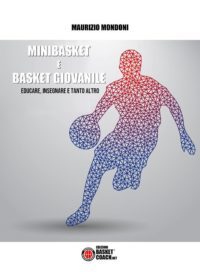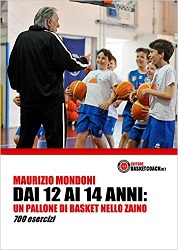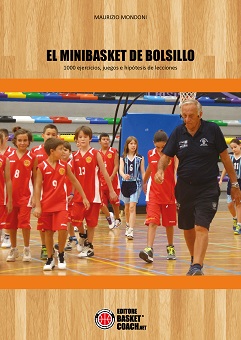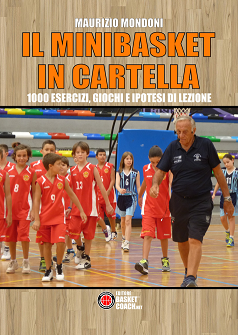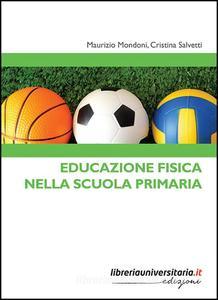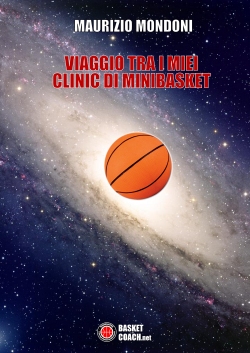My Minibasket Philosophy (part 2)
My Minibasket Philosophy (part 2)
MINIBASKETBALL AND BASKETBALL: GENERAL GUIDELINES
1°STAGE: multilateral preparation
MINIBASKETBALL (6-12 years)
Minibasketball is a team game-sport educational, using a ball, and is situational, acyclical, symmetrical and mixed-type (alternate aerobic-anaerobic). Playing Minibasketball, a child educates his sensitive-perceptive abilities, motor and postural pattern, socializes, communicates, measures his own abilities, controls himself, he enjoys; he learns the fundamentals of basketball.
Minibasketball promotes:
– a harmonic muscular development. In fact, the four limbs have to be moved together in the run, in the dribble, in the shots, in passages, and in movements without ball;
– important physiological adaptation, which prepare the most important organs to the following cardio-vascular, respiratory and neurovegetative efforts;
– makes possible to progressively transform simple abilities (such as basically motor pattern) into complex abilities (such as basketball fundamental), through education and development of motor abilities.
Motor and postural patterns (simple abilities)
Motor patterns, the basic unit of movement, are the spontaneous expressions of movement, the actual basis on which general abilities are constructed, such as:
– walking;
– running;
– jumping;
– throwing;
– catching and receiving;
– kicking;
– sliding;
– rolling;
– climbing;
– maintaining one’s balance
– pushing;
– aiming, hitting
In this age group (6-8 years), it is possible to acquire more complex motor patterns such as swimming, skiing, skating, etc., providing these actions are constructed on top of the broader base of motor and postural patterns.
Motor patterns may involve the entire body or parts of the body in its performance. When the parts of the body are involved in movement, without the dynamic movement of the whole body, postural patterns are involved (flexing, bending, abducting, adducting, twisting, flinging, etc.). Motor patterns must be mastered, used, varied, and used in combinations, reused, using different equipment and objects.
Motor abilities
Motor abilities, essential for performances ability and for knowingly performing motor and sport actions, may be defined as “individual motor predispositions which, in to be trained and developed, require a correct and progressive work methodology”.
During childhood, it is important for work to be “targeted” towards the education and development of coordination motor capabilities, joint mobility capacity and the structuring of conditional capacities, in keeping with different individual learning rates and workloads.
The coach’s work should begin from the analysis of individual pre-qualification (requirements), structural and functional and he should tend towards the improvement of the basically and postural motor pattern, through education and development of motor abilities, until progressively transform them into specific abilities (individual fundamentals of basketball), respecting all the individual step of learning (raw coordination step, fine coordination step, stabilisation and variable availability).
The percentages of general and specific preparation vary according to age. The general preparation must be the solid foundations on which it will be possible to build the specific preparation.
It is not possible to improve the executive technique if nobody educates and develops individual motor abilities in the beginning.
Work must be programmed and scheduled (macro-cycles, monthly cycles, micro-cycles), and objectives must be beforehand and subsequently verified.
There are many different classifications of motor abilities and we have adopted the following classification:
– conditional;
– joint mobility (suppleness);
The dividing lines between these abilities are not easy to determine, and when one of these abilities is trained and developed, the other abilities are educated and developed too.
The development of motor abilities is continuous and progressive but not linear, and for certain ages there are periods (“sensitive” phases) in which growth is very high, especially in the period from 6 to 13-14 years of age.
It is important for the coach to be aware of these sensitive phases and to avoid seeking progress too soon in order to obtain optimal performance immediately without their being the prerequisites necessary for achieving such a performance.
It is necessary to avoid:
1. an anticipation of natural time and a requirement of optimal performance too early, without having the presupposition to achieve them;
2. an automatic anticipation of rigid gestures and movements;
3. to specialize in advance role and position in the game.
The coach has to know and to show well the fundamentals of basketball, he has to know when and how to correct and improve, he has to know how to correctly use the feed back, he has to communicate and make the communication easy between those who are playing basketball.
It is also necessary to respect the various phases of learning and individual rates, to consider the importance of the phase know as restructuring of motor abilities, it is not a question of finding a champion among the group but rather of providing all pupils with the opportunity to express them and verify how much the have to offer.
Conditional abilities
Conditional abilities are basically determined by energetic, metabolism and plastic processes (availability of energy) and can be broken down into three systems:
– strength
– resistance
These abilities follow a quite linear development as the child grows, slowing down in the period of puberty and “exploding” later on.
Each conditional ability may be linked during work to another conditional ability by means of a structural relationship, so that we shall have.
It is necessary to work in this period (6-12 years) on the structuring of these abilities, so that they can be developed later on.
Strength
This is the ability of the muscles (white or rapid, slow red fibres) to develop tension (through muscular contraction), required to overcome or to oppose resistance.
In Minibasketball strength must initially be considered as the child’s body robustness in dealing with actions with and without the ball during a match (running, jumping, throwing, etc.).
To obtain body robustness means to invigorate abdominal and dorsal part of the body, to develop muscles of the lower limbs (in order to jump) and upper limbs (shoots and passages).
Resistance to be overcome in Minibasketball includes the weight of one’s body (relative strength) and the weight of the ball.
For this reason, it is very important to work with natural load, in pairs and with small gymnastic equipments (balls, circles, sticks, etc.), in order to educate strength and rapidity, (ability in running, jumping, shooting), which is possible to be seen in movements without ball, in offence and in defence, in shooting, rebounds and in passages.
Strength ability is clearly linked to resistance and rapidity abilities, and work performed on one of them mutually conditions the others.
It is important to mobilise prior to strengthening, therefore mobilisation forms the basis for strengthening (avoid stretching until the age of 12 or 13). It is necessary to avoid overburdening children at the outset, since the main thing is not to develop strength too early and unconditionally (even though positive results can be obtained immediately by using high workloads), but rather to improve strength in relation to the pupils’ age, gender, maturity of the muscular system, support apparatus and hormonal production, so that it can be developed at a later stage.
Resistance
This is the ability that enables an organism to resist the fatigue of a given physical work, without this leading to a drop in mental and physical effort (performance must remain constant).
As far as Minibasketball is concerned, this ability may be considered as the child’s ability to “play the game” (4 quarter of eight minutes each, each players having to play two quarters at most), bearing in mind that for 16 minutes the workload is not excessive, since there are pauses, timeouts, etc.
When children play, the cardio-circulatory and respiratory apparatus, cellular metabolism processes (recover times being important); workloads and respiratory training are involved.
In this period, children are endowed with great aerobic ability (they can play for a long time without tiring if the activity is something that interests them), but they also can provide anaerobic, non-consecutive performance (poor level on anaerobic ability).
The Instructor must aim to build a sound “basic resistance”, serving as a basis for specific resistance qualities (running, dribbling, and shooting, passing).
At the age of 11 or 12, resistance ability can easily be trained, using enjoyable exercises (with and without the ball), either individually or in pairs or groups (circuit-training, relay race, etc.) with workload gradually increased.
Rapidity
This is the ability to perform motor actions as quickly as possible. Factors determining this ability are:
– motor response time (response rapidity);
– rapidity of each single movement (performance rapidity);
– frequency of movements;
– strength and coordination required for performance.
All these factors come together to determine rapidity performance. In Minibasketball, every action is quick (dribbling, shooting, passing, movements without ball in offence and in defence); there are specific “times” that must be respected (3-5”), spaces (length and width of the “field”, areas, central circuit), so that rapidity in ability must be educated since the beginning if the willing is to prepare rapid and quick movements.
In the gym, the coach must present children with exercises-games that offer a gradual increase in ball speed, the use of different balls and larger balls, different stimuli, and different starts and finishes, since performance will deteriorate if the exercise begins and ends in the same way.
Joint mobility
This is the ability to perform movements with ample joint extension, moving close to the limits of the allowed individual physiological range.
This is an intermediate ability between the conditional and coordination abilities and it is a prerequisite for the economic performance of movements and gestures.
Being flexible in Minibasketball, means knowing how to run, how to jump, how to dribble, how to pass the ball and how to shoot.
Inadequate joint mobility has a negative bearing on the technical learning of specific gestures.
On the other hand, a good level of joint mobility serves as prevention against injuries and increases performance rapidity and accuracy.
The coach must “play to mobilising” the main joints of the body, getting pupils to perform ball-handling, using small props (sticks, rings, etc.) either individually or in pairs.
Stretching should be proposed after 12 years age, because articulations and muscles are not ready to stand such kind of work that involves a protracted extension.
Coordination abilities
Coordination abilities are determined by movement control and regulation processes and are based on the acquisition and elaboration of information and on the control of performance.
Analysers, enabling the development of the ability to organise and the control of movement, perform all of the above.
These abilities can easily be trained from 6 to 12 year age group (the period of most intense development), leading to a gradual improvement in motor coordination (the “magic moment”).
The best period for learning movements is from 10 to 13 years for males and from 10 to 12 for females.
Coordination abilities must be educated and developed at the same time as conditional abilities and joint mobility at the age of 12 or 13, so that in the subsequent period (restructuring of motor abilities) pupils can adapt to any motor situation that arises.
The best methodology for the education of these abilities is that of training them in a way as varied as possible, diversifying spaces, execution times, the weight of equipment, performance with the non-dominant limb, different starting and finishing positions, performance rate, delayed performance, in unbalanced states, with eyes closed, modifying stimuli (hear, sight, touch).
Coordination abilities, interacting with each other, determine playing skills, which can be assessed according to the following prerequisites (mental requirements, technical requirements and tactical requirements).
Conditional abilities are broken down into:
– general;
– special.
General condition abilities are broken down into:
– motor learning;
– motor adaptation and transformation;
– motor control.
Motor learning
This is the ability to modify every motor situation by virtue of one’s experience. The child learns information from the coach through his sensory organs, storing in his memory the information that has gratified him and using it during play. The more motor experiences he possesses the better he plays.
It is important for the coach to correctly demonstrate the gestures being taught, explaining gestures using at easy to understand language so that children can subsequently perform them to the best of their ability.
Adaptation and motor transformation
This is the ability to transform and adapt the motor programme in relation to sudden changes to what is happening during play.
In Minibasketball a number of situations crops up on court, caused by the behaviour of team-mates, opponents, the setting, etc.
It is important, for example, to teach children different shooting types (and not just one, even if it is perfect), so that they are able to adapt to different situations arising during play.
Motor control
This is the ability to control and direct the gesture or movement according to a pre-arranged plan of action.
In Minibasketball children are initially unable to control the ball when dribbling, shooting and passing, they run and jump badly and uneconomically.
At this age it is difficult to control gestures, therefore the coach must present every different play situation (in space and time), so that the child is able to control his own gestures in relation to what is happening during play.
Special coordination abilities are broken down into:
– motor combination (coordination);
– balance;
– orientation;
– differentiation (space-time and dynamic);
– anticipation and choice.
Motor combination
This is the ability to unite several independent and partial forms of movements into a single structure; these forms may appear in a sequence or at the same time.
This requires a perfect understanding between the locomotors apparatus and the central nervous system.
During the practice the coach must present game-drills of simple coordination (eye-hand coordination, eye-foot coordination), varying starting, intermediate and finishing position, requiring the use of one or both parts of the body.
Coordination may be defined as “dynamic balance”, and to train and develop this ability exercises-game can be proposed using natural workloads, with the ball, ring, and stick, skipping rope, working in pairs.
Balance
This is the ability to maintain a correct body position in space (from a standing position or in movement), and it is also to ability to recover this position if it has been lost.
This ability is fundamental in Minibasketball for keeping the body when dribbling, shooting, and passing, offence movements without ball and defence movements.
It is a neuro-muscular sensation that is acquired gradually and requires effort and operating with tranquillity.
It is important to work on both static balance (throw-ins, shooting, throws) and dynamic balance (rebounds, shooting and passing while in movement, 1 on 1 situation with the ball, etc.).
The coach must present exercises-game on the ground, of pre-acrobatic, in “flight”, with and without ball, with closed eyes, with an opened eye and the other closed, on different pavements. All this is necessary to challenge the balance, improving the possibilities.
Orientation
This is the ability to determine and vary the position and movements of the body in space (spatial sensitivity).
In Minibasketball, the perception and the variation of his-her own position are practiced in the court and with specific point of referee (team-mates, the opposing team, the ball, the chest) and movements have to put in situations of games, which constantly change.
This ability is related to balance ability and must be educated and developed in a way, that children are able to progressively understand when they are in the middle of the court, close to side-lines and base-lines, in the middle of the opposing area, close or far from the basket, close to team-mates or to opposing team.
Differentiation
This is divided into:
– space-time differentiations;
– dynamic differentiations.
Space-time differentiations ability is a person’s ability to give a chronological-spatial consequential order to partial motor processes, linking them together until they become a single and final motor act.
Dynamic differentiations ability is a person’s ability to differentiate discriminate and further specify sensations obtained from objects and events through the sensory organs in order to better meet the needs of different situations arising during play.
This ability is closely tied up with the space-time differentiations ability, and both abilities favour the acquisition of execution rhythm, essential for performing any technical gesture or movement.
It would be interesting to work in the gym with background music (no words, just music), with continuous changes of rhythm and volume.
Anticipation and choice
This is the ability to predict correctly according to the laws of probability, both the performance and the outcome of an action, and therefore foresee subsequent operations.
Anticipating entails the analysis of a situation does not exist at the present time.
This is the most important ability in Minibasketball and in sports in general.
In Minibasketball we may define this ability as “the ability to use the gesture or movement most suited to the particular situation arising during play”.
The coach must present exercises-games (initially simple and before more difficult): 1 vs 1, 2 vs 1, 1 vs 2, 2 vs 2, 3 vs 1, etc. (tout court, half court, short spaces, in short playing time).
Motor ability
These are actions, which through repeated exercise become established subsequently automated, without consciously on what one is doing (movement security).
Factors of motor and sporting performances
By teaching and developing individual motor abilities, motor patterns (general motor abilities), are gradually transformed into specific motor skills. In order to achieve motor and sporting performances (performance ability), it is therefore necessary for the pupil to be prepared for such a performance and be in possession of character, personality and motor intelligence.
Performance ability and a predisposition for performance, together with the education and development of motor abilities and skills, help defining and forming the factors going to determine performance.
It is important to begin by working on the creation of a sound “multilateral basis” on which to construct a basis taking the pupil towards different sports (specific work for each sport).
In order to achieve a progressive increase in performance ability it is necessary to know the individual’s “initial situation”, so as to plan for correct workloads and use correct teaching and training methodologies.
This initial evaluation can be carried out mainly through the use of a battery of tests:
– anthropometric;
– functional;
– psychological and sociometric;
– motor (general and specific).
After this initial assessment, it is important to proceed with intermediate assessments (verification) after a given period of time, and the end of activities a final evaluation enables the coach to have a complete picture (global and individual) and verify whether the work performed has achieved set goals.
Each coach should keep an individual progress report for each pupil, containing personal data, anthropometrics, functional and motor data and the dates of medical controls.
Test for 8-9 years olds may be proposed in the form of races, results being put up on the gym notice board.
From the age of 10-11, results begin to become reliable if tests are given on a continuous basis (for 2 or 3 years).
Tests must be given in several practices (being repeated once, twice or three times depending on the intensity of the test, choosing either the best performance or the average result), possibly at the same time in the same place.
It is important to explain the test to pupils before it is performed and to do sufficient warm-up before its performance.
As far as motor tests are concerned, we propose an easy applicable “battery of tests”:
– measure the weight;
– measure the height;
– Lyan test: perform running on the sport for 1 minute and measure heartbeat. Verify the children’s recovery rate: within 2 minutes excellent, within 3 minutes good, within 4 minutes poor, after 6 minutes very poor (1 attempt);
– Martinet test: perform 15 leg flexes for 1 minute and measure recovery time: within 1 minute excellent, within 1,5 minutes good, within 4 minutes poor (1 attempt);
– Hirtz index: measure the chest circumference when breathing out and breathing in. Calculate the difference in centimetres: from 3-5 normal, from 6 to 8 excellent (1 attempt);
– long jump from standing position: starting from a standing position with feet firmly together, jump forward and measure length of the jump (3 attempts);
– long jump with run-up (3 attempts);
– Seargent test: standing next to the wall, without going on tip toes, the pupil child make a sign on the wall with a piece of chalk. He must then bend his legs, jump upwards and make a sign with the chalk as high as he can reach: The difference between the first and second mark constitutes the height of the jump;
– 20 metres sprint (in the gym or outdoor): the start watch begins when the child removes his foot from the ground to begin sprinting and stops when it reaches the finishing line (3 non-consecutive attempts);
– throwing a Minibasket ball: from a sitting position with one’s back against the wall, legs spread apart, throw the ball forward with both hands from the chest. Measure the distance throw (3 attempts);
– mobility of the scapulo-humeral girdle: the child, with arms extended, takes hold of a stick (round and graduated) at the two ends, makes a circle with the stick, passing it over his shoulders until the stick touches his back, before returning to the initial position (again with arms extended). The test should be performed in series, gradually diminishing the hold. The final test performed without flexing the arms should be measured;
– Fleishman test: place one foot on a wooden plank 5 centimetres wide, close eyes and raise the other foot, remaining in a balanced position for as long as possible. Record the time in this position 2 or 3 seconds, average, 3 or 4 seconds good, over 5 seconds excellent (3 attempts);
– rolling: get the child to do a forward roll, finishing the action on his feet (check the balance position): 3 non-consecutive attempts;
– throwing of tennis-ball: throw 6 tennis-ball (one at a time) at a target circle (30 centimetres in diameter) drawn on the wall (from a distance of 2 metres). Count how many times the centre of the circle is hit;
– ball-handling (choosing a series of exercises of ball-handling): to count how many executions a child does in 30 seconds;
– dribbling with the right and left hand: verify how long it takes the pupil to dribble down the entire court (28 metres) from a standing position from a baseline. Make 3 attempts (not consecutive), start the watch when the pupil begins to dribble and stop it when he reaches the opposite baseline;
– shooting: throw the Minibasketball 10 times from the free-throw line and count how many baskets the pupil scores. This test can be performed by shooting from other positions (from the left, the right, with or without the aid of the backboard);
– passing: count how many two-handed chests passes the child can make against a wall in 30 second (from a distance of 2 metres);
– defending: “slide” from ore sideline to the other (there and back). Measure the time taken (2 non-consecutive attempts). It is not allowed to run or to cross one’s legs; both feet must touch the sidelines.
Conclusion
A child learns what he really lives and for this reason the Instructor must manage to create for him a real situation in the practice, so that when he plays the game, he can find the same situation that he had tried in the practice and to be good in getting over the sparkling way.
—————————————
ALTRI ARTICOLI GIA’ TRATTATI SUL BLOG NELLE CATEGORIE. CLICCA SULLE CATEGORIE PER LEGGERLI.
TECNICA
ESERCIZI
COMUNICAZIONE
SCUOLA E MINIBASKET
MINIBASKET NEL MONDO
PEDAGOGIA
FISIOLOGIA
VIDEO
SCARICA GRATIS LA MIA DISPENSA L’ALLEDUCATORE
Vi ricordo che potete iscrivervi alla mia newsletter gratuita, per restare sempre aggiornati sul #minibasket a misura di bambino. In regalo la dispensa l’Alleducatore.
Prof. Maurizio Mondoni
#iostoconibambini
#alleducatore
#minibasket
